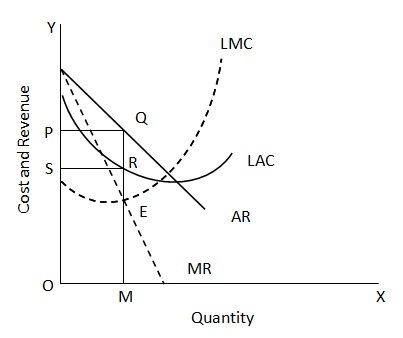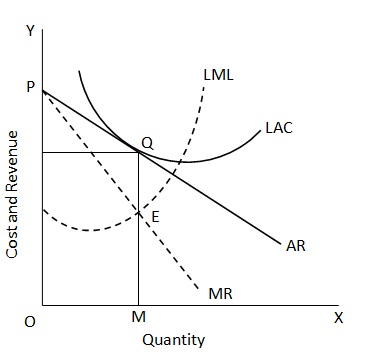A monopoly firm is a single seller in the market, with no close substitutes of that product and virtually no threat of entry of the new firms. The monopolist thus enjoys considerable market power to dictate his terms with respect to price or quantity sold of his output. Due to these conditions, the demand curve or AR facing the monopolist is relatively inelastic compared to the one facing the firm under monopolistic competition where the competition from other firm’s producing close substitutes is quite intense. In the following diagrams we show the long – run equilibrium of a firm under monopoly and monopolistic competition.


The long-run equilibrium of a firm under monopolistic competition. It may be observed that AR curve facing a monopoly firm is less elastic compared to the one facing under monopolistic firm. The respective equilibrium positions
Both the monopoly firm and the firm under monopolistic competition may be earning supernormal profits in the short-run. But in the long – run equilibrium, the monopoly may still continue to earn these supernormal profits as its MR = MC but AR < AC and hence total revenue exceeds total cost.
However, the firm under monopolistic competition cannot earn supernormal profits in the long – run. This is because it’s short – run supernormal profits attract new firms that compete away these profits. Hence, in the long run equilibrium of the firm MR = MC and AR = AC, thus making its total revenue just equal to its total cost, thereby eliminating the possibility of earning supernormal profits.
A comparative picture of equilibrium of a monopoly firm and a firm under monopolistic competition is given below:
Comparison of firm’s Equilibrium under Monopoly and Monopolistic Competition
| Monopoly Firm | Firm under Monopolistic Competition |
| The demand curve or AR curve is relatively inelastic. | The demand curve or AR curve is relatively more elastic. |
| The firm seeks to maximize profits by (i) Charging higher price per unit and (ii) Restricting the quantity of output. |
The firms seeks to maximize profits by (i) Charging higher price per unit and (ii) Producing and selling large quantity. |
| The firm may be producing identical products or differentiated products. | The firm produces differentiated products. |
| The firm incurs no selling costs. | Selling costs are an integral features of every firm. |
| The firm may earn super normal profits in long-run. | All firm produce at less than the capacity level, thus there exist capacity. |
| There is inefficiency in allocation of resources because p > MC for the firm | In this market too, there is inefficiency in resources allocation as P > MC for each firm. But this inefficiency is lower than that under monopoly. |